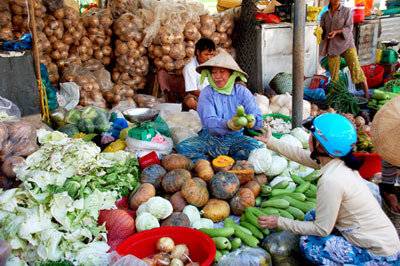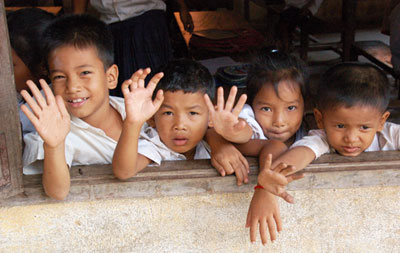Siem Reap to Saigon – a relaxing river cruise through Cambodia and Vietnam
This article appears on page 18 of the August 2015 issue.
In contemplating a trip to Southeast Asia, there are few adventures more alluring than taking a slow boat down the Mekong River. Standing atop the breezy deck of a comfortable, modern riverboat as it cruises past lush rice fields, towering palm trees and lazy fishing villages affords one of those rare experiences that simultaneously relaxes the body while energizing the mind.
When my wife, Arlene, and I started preparing for our 2015 Southeast Asia trip several months in advance, we knew we wanted to spend one of our travel weeks on the lower Mekong, sailing from Siem Reap in Cambodia to the Delta in Vietnam. A growing number of boats, ranging from the basic to the luxurious (with prices to match), now ply this route, but it didn’t take a lot of online research to zero in on the 32-cabin, 3-deck vessel that offered the ideal combination of sailing date, itinerary, comfort and price: the Mekong Prestige II.
Making arrangements
We made our arrangements through Viet Prestige Travel (phone +84 4 6686 5833, www.vietprestigetravel.com), a Hanoi-based agency that responded courteously and promptly to all of our emailed inquiries… and there were many!
We wanted adjacent cabins on the upper deck for our party of two couples. (We were traveling with our friends Des and Martha Dutrizac of London, Ontario, Canada.) We asked about the food, the crew, the payment schedule and credit card charges (in both US and Canadian dollars), the pickup arrangements in Siem Reap and the details of how we would get from My˜ Tho, where the cruise ended, to Ho Chi Minh City (Saigon), about 40 miles to the north.
Ms. Hoa Pham was our designated agent, and she was wonderful. Her command of English was excellent. She never failed to answer an email within 24 hours.
She made adjustments to our itinerary as necessary and organized several flights, transfers and a couple of guided tours for our post-cruise travels in Vietnam.
And when we got to Hanoi a week after the cruise ended, Hoa showed us the ultimate in personalized service, treating the four of us to dinner at a lovely restaurant. We made a wise choice of agencies in Viet Prestige Travel and a lifelong friend in Hoa Pham.
Getting started
The cruise was everything we hoped it would be. After two weeks of setting our own brisk pace — traveling from the soaring skyscrapers of Hong Kong to the teeming streets of Bangkok to the serene ancient Thai capital of Ayutthaya to the awesome splendor of the Angkor temples — we were ready to settle into a large, comfortable floating cabin for a week and let the sights come to us.
First, however, we had an unexpected diversion. Because our cruise was in mid-March, toward the end of the dry season, we knew there was a possibility that we might have to take a small boat or a bus from Siem Reap several miles downstream to a point on the Tonlé Sap River where the water was deep enough for the Mekong Prestige II to navigate. What we hadn’t counted on was a 5-hour bus ride on a “national highway” marked by crater-size potholes, rickety one-lane bridges with no guardrails and a steady stream of slow-moving, overloaded trucks that our driver would pass at breathtaking speed, always returning to the correct lane in the nick of time to avoid oncoming trucks of even greater girth.
We were treated en route to a couple of pit stops to visit the “happy room” or to sample a local culinary specialty, deep-fried tarantula.
Yet within a few minutes of our arrival at the Mekong Prestige II, this ordeal was but a distant memory. Greeted by our gracious cruise director, Gaby, we quickly learned that only 18 of the 32 cabins would be occupied on this voyage. In addition to the four of us, our fellow passengers would be one Belgian couple, one German couple and a tour group of 28 South Africans.
Fortunately for us, the South African group had its own tour guide, as did the Germans. This meant that every time we went ashore, which we did frequently, we had what amounted to a private tour with an English-speaking guide for our small American-Canadian-Belgian contingent.
On the river
Our cruise began in Kampong Chhnang, an important fishing port on the Tonlé Sap River featuring a sprawling, picturesque floating village and a bustling and equally picturesque morning market.
Over the next three days in Cambodia, we would make several stops as we cruised down the Tonlé Sap. We would visit two beautiful pagodas in the village of Kampong Tralach; an enormous Buddhist temple in the ancient capital of Oudong; a primary school in Kaôh O˘knha Tey, and numerous sites in the capital city of Phnom Penh, including the impressive Royal Palace, National Museum and Wat Phnom as well as the chilling Tuol Sleng Genocide Museum.
A few of us took advantage of some free afternoon time to tour the infamous Killing Fields — a visit made all the more poignant having seen the film of the same name on board the previous evening.
The Tonlé Sap meets the Mekong in Phnom Penh, and our journey downstream on the bigger, busier river took us across the border into Vietnam at Tan Chau, where we visited a silk factory, a mat factory and a fish farm.
Our next stop, at Sa Dec, featured a walk through the local market and a stop at a colorful Cao Dai temple, the prayer hall of the indigenous Vietnamese religion that incorporates elements of Buddhism, Christianity, Hinduism, Islam, Confucianism, Judaism and Taoism and celebrates the teachings of an unusual trinity: Chinese revolutionary Dr. Sun Yat-sen, 16th-century Vietnamese poet laureate Nguyen Binh Khiem (aka Trang Trinh) and French novelist Victor Hugo.
Also of interest in Sa Dec was a visit to the so-called House of the Lover, a traditional Chinese home with furnishings from the early 20th century. For those on board who were unfamiliar with the autobiographical novel “The Lover” by Marguerite Duras, set in the 1920s in Sa Dec and Saigon, Gaby was kind enough the previous evening to show the movie version, directed by Jean-Jacques Annaud, which offered a decidedly graphic representation of the goings-on between a lonely French teenager and her older Chinese consort.
A few final stops
Our next stop, Cái Bè, was highlighted by a brief visit to a Catholic cathedral and a longer stop at a local factory that produced all manner of rice products, including rice paper, popped rice and rice wine (with or without a snake in the bottle), plus coconut candy.
Also on offer, as at virtually all of our stops in Vietnam, was a large assortment of handicrafts and souvenirs made of silk, wood, lacquerware or bamboo along with stacks of 1960s Zippo lighters engraved with a variety of slogans (some of them unsuitable for publication in this magazine), once popular among American servicemen.
As interesting as we found each of these onshore destinations, the means of transportation employed to get us there were perhaps even more memorable. Most of our ship-to-shore transfers were done by small boat, the 28 South Africans in one, the eight of us in another. Once on dry land, we were transported by every conceivable 2- or 4-wheel vehicle: bus, van, tuk-tuk, rickshaw and, in one particularly memorable instance, ox cart.
Life on board
Lastly, here are a few details about the facilities on board the Mekong Prestige II.
The cabins are roomy — 20 square meters, or 215 square feet — and the en suite bathrooms are surprisingly large. Every cabin is air-conditioned and has a balcony, though the heat and humidity may inhibit more than occasional use.
The public areas, including the indoor lounge and outdoor deck (with a small, cool plunge pool), were more than comfortable.
The restaurant, staffed by friendly Vietnamese and Cambodian servers, provided three full meals every day. The buffet breakfast included made-to-order eggs and Asian noodle dishes, while lunches and dinners featured three entrée options — meat, fish or vegetarian — with an open salad bar and a choice of starters and desserts.
Best of all, soft drinks, most mixed drinks and local wines were available at all times without charge. “Premium” drinks (made with name-brand imported liquor) could also be ordered, at nominal cost.
Bottled water was always available in the room, the restaurant and the lounge, and ample supplies of cold water were provided on those sweat-inducing shore excursions.
The bill for our 8-day, 7-night downstream cruise on the Mekong Prestige II was $1,780 per person, or $3,560 for the two of us. This included our upper-deck cabin with king-sized bed; three meals a day with beverages; all shore excursions; our transfer by bus from Siem Reap at the start of the cruise and by van to our hotel in Saigon at the end, and tips.
The cost of getting to Cambodia? A whole lot of frequent-flyer miles plus a low-cost Bangkok-to-Siem Reap flight on Air Asia.
The value of the whole experience, measured in US dollars, Canadian dollars or any other currency? Priceless.




